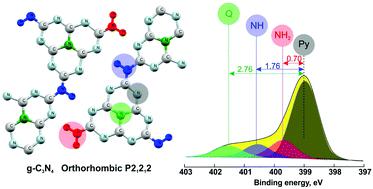当前位置:
X-MOL 学术
›
Dalton Trans.
›
论文详情
Our official English website, www.x-mol.net, welcomes your
feedback! (Note: you will need to create a separate account there.)
Elucidating the structure of the graphitic carbon nitride nanomaterials via X-ray photoelectron spectroscopy and X-ray powder diffraction techniques.
Dalton Transactions ( IF 3.5 ) Pub Date : 2020-09-04 , DOI: 10.1039/d0dt02325f Emilia Alwin 1 , Waldemar Nowicki 2 , Robert Wojcieszak 3 , Michał Zieliński 2 , Mariusz Pietrowski 2
Dalton Transactions ( IF 3.5 ) Pub Date : 2020-09-04 , DOI: 10.1039/d0dt02325f Emilia Alwin 1 , Waldemar Nowicki 2 , Robert Wojcieszak 3 , Michał Zieliński 2 , Mariusz Pietrowski 2
Affiliation

|
By using the most popular method of thermal condensation of dicyandiamide in a semi-closed system, graphitic carbon nitrides (gCNs) were synthesized at 500, 550, and 600 °C. The resulting materials were comprehensively analyzed via X-ray photoelectron spectroscopy (XPS) and X-ray powder diffraction (XRD)techniques. We show that the use of routine analytical methods provides an insight into the structure of the carbon nitride materials. The analysis of geometric linear structures and fully condensed structure of polymeric carbon nitrides was performed and the ranges within which the contents of different nitrogen species (pyridine, amine, imine and quaternary nitrogen) can change were determined. This analysis, in combination with quantitative XPS studies, permits to state that the carbon nitride structure prepared by the thermal condensation of dicyandiamide is closer to the structure in which poly(aminoimino)heptazine subunits are linked into chains rather than the structure involving fully-condensed polyheptazine network. The XRD analysis proved that the 3D crystal structure of carbon nitride is described more correctly by the orthorhombic cell and space group P21212 applied to condensed chains of poly(aminoimino)heptazine (melon) and not by the hexagonal cell with the space group P6m2.
中文翻译:

通过X射线光电子能谱和X射线粉末衍射技术阐明了石墨氮化碳纳米材料的结构。
通过在半封闭系统中使用最流行的双氰胺热缩合方法,在500、550和600℃下合成了石墨碳氮化物(gCN)。产生的材料通过X射线光电子能谱(XPS)和X射线粉末衍射(XRD)技术。我们表明,使用常规分析方法可以深入了解氮化碳材料的结构。进行了聚合碳氮化物的几何线性结构和完全缩合结构的分析,并确定了不同氮物种(吡啶,胺,亚胺和季氮)的含量可以变化的范围。结合定量XPS研究,该分析表明,通过双氰胺的热缩合制备的氮化碳结构更接近于聚(氨基亚氨基)庚嗪亚基连接成链的结构,而不是涉及完全缩合的结构。多庚嗪网络。P 2 1 2 1 2适用于聚(氨基亚氨基)庚嗪(瓜)的稠合链,不适用于空间群为P 6 m 2的六角形细胞。
更新日期:2020-09-22
中文翻译:

通过X射线光电子能谱和X射线粉末衍射技术阐明了石墨氮化碳纳米材料的结构。
通过在半封闭系统中使用最流行的双氰胺热缩合方法,在500、550和600℃下合成了石墨碳氮化物(gCN)。产生的材料通过X射线光电子能谱(XPS)和X射线粉末衍射(XRD)技术。我们表明,使用常规分析方法可以深入了解氮化碳材料的结构。进行了聚合碳氮化物的几何线性结构和完全缩合结构的分析,并确定了不同氮物种(吡啶,胺,亚胺和季氮)的含量可以变化的范围。结合定量XPS研究,该分析表明,通过双氰胺的热缩合制备的氮化碳结构更接近于聚(氨基亚氨基)庚嗪亚基连接成链的结构,而不是涉及完全缩合的结构。多庚嗪网络。P 2 1 2 1 2适用于聚(氨基亚氨基)庚嗪(瓜)的稠合链,不适用于空间群为P 6 m 2的六角形细胞。











































 京公网安备 11010802027423号
京公网安备 11010802027423号